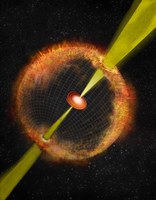An Orphan Gamma-ray Burst
 Casey Law et al. present the discovery of a slowly evolving, extragalactic radio transient, FIRST J141918.9+394036, identified by comparing a catalog of radio sources in nearby galaxies against new observations from the Very Large Array Sky Survey. Analysis of other archival data shows that FIRST J141918.9+394036 faded by a factor of ~50 over 23 years, from a flux of ~26 mJy at 1.4 GHz in 1993 to an upper limit of 0.4 mJy at 3 GHz in 2017. FIRST J141918.9+394036 is likely associated with the small star-forming galaxy SDSS J141918.81+394035.8 at a redshift z = 0.01957 (d = 87 Mpc), which implies a peak luminosity νL ν ≳ 3 × 1038 erg/sec. If interpreted as an isotropic synchrotron blast wave, the source requires an explosion of kinetic energy ~1051 erg some time prior to the authors’ first detection in late 1993. This explosion is most likely associated with a long gamma-ray burst (GRB), but the radio source could also be interpreted as the nebula of a newly-born magnetar. The radio discovery of either of these phenomena would be unprecedented. Joint consideration of the event light curve, host galaxy, lack of a counterpart GRB, and volumetric rate suggests that FIRST J141918.9+394036 is the afterglow of an off-axis ("orphan") long GRB. The long time baseline of this event offers the best available constraint in afterglow evolution as the bulk of shock-accelerated electrons become non-relativistic. The proximity, age, and precise localization of FIRST J141918.9+394036 make it a key object for understanding the aftermath of rare classes of stellar explosion.
Casey Law et al. present the discovery of a slowly evolving, extragalactic radio transient, FIRST J141918.9+394036, identified by comparing a catalog of radio sources in nearby galaxies against new observations from the Very Large Array Sky Survey. Analysis of other archival data shows that FIRST J141918.9+394036 faded by a factor of ~50 over 23 years, from a flux of ~26 mJy at 1.4 GHz in 1993 to an upper limit of 0.4 mJy at 3 GHz in 2017. FIRST J141918.9+394036 is likely associated with the small star-forming galaxy SDSS J141918.81+394035.8 at a redshift z = 0.01957 (d = 87 Mpc), which implies a peak luminosity νL ν ≳ 3 × 1038 erg/sec. If interpreted as an isotropic synchrotron blast wave, the source requires an explosion of kinetic energy ~1051 erg some time prior to the authors’ first detection in late 1993. This explosion is most likely associated with a long gamma-ray burst (GRB), but the radio source could also be interpreted as the nebula of a newly-born magnetar. The radio discovery of either of these phenomena would be unprecedented. Joint consideration of the event light curve, host galaxy, lack of a counterpart GRB, and volumetric rate suggests that FIRST J141918.9+394036 is the afterglow of an off-axis ("orphan") long GRB. The long time baseline of this event offers the best available constraint in afterglow evolution as the bulk of shock-accelerated electrons become non-relativistic. The proximity, age, and precise localization of FIRST J141918.9+394036 make it a key object for understanding the aftermath of rare classes of stellar explosion.
Image: Radio images of FIRST J1419+3940 from 1993 to 2017 show its slow fade. Credit: Law et al., Bill Saxton, NRAO/AUI/NSF
Publication: C.J. Law (University of California, Berkeley) et al., Discovery of the Luminous, Decades-long, Extragalactic Radio Transient FIRST J141918.9+394036, Astrophysical Journal Letters, 866, L22 (20 October 2018).




Connect with NRAO